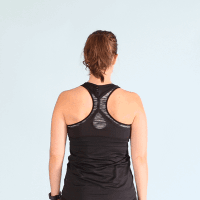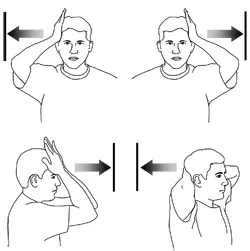For many, the slow, creeping onset of neck pain is more than just an occasional discomfort—it’s a daily battle, a restricting chain that binds one’s freedom. If you’ve been diagnosed with ankylosing spondylitis, you understand this all too well. The pain, stiffness, and limited range of motion can feel like a vice grip around your life. But what if there was hope? What if, nestled between the countless medical terminologies and overwhelming information, there were straightforward exercises and treatments to reclaim some of that lost freedom? If you’re searching for that glimmer of relief, that path to better days, then read on. Let’s explore, together, how to ease the discomfort and navigate this journey towards a more pain-free existence.
Contents
Understanding Ankylosing Spondylitis
 Ankylosing spondylitis (AS) is more than just a mouthful to pronounce; it’s a type of inflammatory arthritis that primarily targets the spine. Over time, the inflammation can cause vertebrae, the individual bones of the spine, to fuse together. This fusion results in a rigid spine, often leading to a hunched-forward posture. But the effects aren’t restricted to the lower back. The neck, or the cervical spine, can also be severely affected.
Ankylosing spondylitis (AS) is more than just a mouthful to pronounce; it’s a type of inflammatory arthritis that primarily targets the spine. Over time, the inflammation can cause vertebrae, the individual bones of the spine, to fuse together. This fusion results in a rigid spine, often leading to a hunched-forward posture. But the effects aren’t restricted to the lower back. The neck, or the cervical spine, can also be severely affected.
The primary symptoms of AS include chronic pain and stiffness, which generally starts in the lower back and buttocks but can ascend to the neck. This discomfort in the neck area can range from a dull ache to a sharp, incapacitating pain, especially upon waking up in the morning or after periods of inactivity. The underlying cause of AS is still a matter of research, but it’s believed to involve genetic factors coupled with environmental triggers.
For many, the neck pain associated with AS isn’t just physical. It restricts mobility, limits daily activities, and can lead to feelings of isolation or depression. Recognizing the connection between ankylosing spondylitis and neck pain is the first step toward finding effective treatments and regaining a semblance of normalcy in daily life.
Why the Neck is Vulnerable in Ankylosing Spondylitis?
The neck, known anatomically as the cervical spine, is a complex and vital structure comprising seven vertebrae, a plethora of muscles, tendons, ligaments, and nerve pathways. However, in the context of ankylosing spondylitis, this very complexity makes the neck particularly vulnerable.
- Vertebral Involvement: While AS commonly initiates in the sacroiliac joints at the base of the spine, its inflammatory nature can travel upwards. The cervical spine, being more mobile and flexible than the thoracic or lumbar regions, can be a hotspot for inflammation. Once inflamed, vertebrae in the neck can undergo calcification processes leading to vertebral fusion, causing rigidity and discomfort.
- Muscular and Ligament Impact: The muscles and ligaments of the cervical region are intricate, meant to support a wide range of motions. AS-induced inflammation can cause these soft tissues to become stiff and painful, limiting their function and causing a sensation of tightness or throbbing in the neck.
- Nerve Compression: The cervical spine is home to numerous nerves branching out from the spinal cord. Inflammation, bone spurs, or vertebral fusion can lead to these nerves being pinched or compressed, leading to sharp pains, tingling, or even numbness.
- Postural Changes: The progressive nature of AS often results in postural alterations. As the thoracic spine becomes more curved, individuals might lean forward, placing additional strain on the cervical spine. Over time, this compensation mechanism can intensify neck pain and discomfort.
Understanding the vulnerability of the neck in the context of ankylosing spondylitis underscores the importance of early intervention and tailored treatment strategies. The sooner one can identify and address these issues, the better the chances of mitigating severe complications and ensuring a higher quality of life.
Physiotherapy and Its Role in Pain Relief
 Physical therapy serves as a cornerstone in the comprehensive management of ankylosing spondylitis (AS), particularly when addressing neck pain. Through a combination of targeted exercises, stretches, and manual techniques, physiotherapy plays a pivotal role in enhancing comfort and mobility.
Physical therapy serves as a cornerstone in the comprehensive management of ankylosing spondylitis (AS), particularly when addressing neck pain. Through a combination of targeted exercises, stretches, and manual techniques, physiotherapy plays a pivotal role in enhancing comfort and mobility.
1. Tailored Exercise Regimens: A skilled physiotherapist designs exercise programs tailored to the specific needs of AS patients.
2. Neck-Specific Stretches: Neck pain resulting from AS can often be alleviated through carefully chosen stretches that gently increase range of motion and reduce muscle tension. Stretches focusing on neck rotation, flexion, extension, and lateral movement can aid in reducing stiffness and promoting flexibility.
3. Posture Correction: Physiotherapists emphasize the significance of maintaining proper posture, both during daily activities and while using electronic devices.
4. Manual Techniques: Hands-on approaches, such as mobilization and soft tissue manipulation, can ease muscle tension and promote joint mobility. Manual techniques also help improve blood circulation to the affected areas, facilitating healing.
5. Patient Education: Beyond in-session exercises, physiotherapists educate patients about the importance of consistent exercise and posture management. Empowering patients with the knowledge to manage their condition independently enhances the effectiveness of physiotherapy.
Incorporating physiotherapy into the treatment plan for AS neck pain yields substantial benefits. The guided exercises and stretches not only reduce discomfort but also empower individuals to actively engage in their own well-being, fostering a sense of control over their condition.
Targeted Exercises for Neck Flexibility
Engaging in targeted exercises is a proactive way to combat neck pain caused by ankylosing spondylitis (AS). These exercises focus on enhancing the flexibility and strength of the neck muscles, promoting better mobility and relieving stiffness. Remember to perform these exercises gently and without force. If you experience discomfort, stop immediately and consult a medical professional.
Neck Rotations

- Sit or stand up straight, keeping your shoulders relaxed.
- Slowly turn your head to the right, bringing your chin over your shoulder.
- Hold for a few seconds, then return to the center.
- Repeat the movement to the left.
- Perform 10-15 repetitions on each side.
Neck Flexion and Extension

- Start with your head facing forward.
- Gently lower your chin toward your chest, feeling a stretch along the back of your neck.
- Hold for a few seconds, then slowly lift your head back to the starting position.
- Now, tilt your head backward, looking up toward the ceiling.
- Hold for a few seconds, then return to the center.
- Perform 10-15 repetitions for each movement.
Shoulder Blade Squeezes

- Sit or stand up straight with your arms by your sides.
- Squeeze your shoulder blades together, gently pushing your chest forward.
- Hold for a few seconds, then release.
- Perform 10-15 repetitions.
Neck Side Bends

- Keep your spine straight and shoulders relaxed.
- Slowly tilt your head to the right, bringing your right ear toward your right shoulder.
- Feel the stretch along the left side of your neck.
- Hold for a few seconds, then return to the center.
- Repeat the stretch to the left side.
- Perform 10-15 repetitions on each side.
Neck Isometric Exercises

- Place your palm against your forehead.
- Gently push your head forward while resisting with your hand, engaging your neck muscles.
- Hold for a few seconds, then relax.
- Place your palm against the back of your head.
- Push your head backward against your hand while contracting your neck muscles.
- Perform 10-15 repetitions for each direction.
Regularly incorporating these exercises into your routine can gradually enhance neck flexibility and diminish pain associated with ankylosing spondylitis.
Alternative Therapies to Explore
In the pursuit of relief from ankylosing spondylitis (AS) neck pain, some individuals have found solace in alternative therapies that complement traditional treatments. These therapies have shown promise in alleviating discomfort and enhancing overall well-being:
- Acupuncture
- Massage Therapy
- Chiropractic Care
- Mindfulness and Meditation
- Dietary Modifications
- Heat and Cold Therapies
While alternative therapies can complement conventional treatments, it’s essential to consult your healthcare provider before embarking on any new therapies. What works well for one person may not yield the same results for another, so it’s crucial to approach these therapies with an open mind and realistic expectations. Integrating these therapies into your overall pain management plan might contribute to a multifaceted approach toward well-being.
Preventative Measures: Keeping the Pain at Bay
 For individuals grappling with ankylosing spondylitis (AS), proactive steps can play a pivotal role in preventing or reducing future flare-ups of neck pain. While AS is a chronic condition, incorporating certain strategies into your daily routine can help you manage discomfort and maintain a better quality of life:
For individuals grappling with ankylosing spondylitis (AS), proactive steps can play a pivotal role in preventing or reducing future flare-ups of neck pain. While AS is a chronic condition, incorporating certain strategies into your daily routine can help you manage discomfort and maintain a better quality of life:
1. Maintain Consistent Exercise: Regular, low-impact exercises are crucial to maintaining joint flexibility and reducing muscle stiffness.
2. Prioritize Good Posture: Consciously sit and stand with proper alignment. Use ergonomic chairs and adjust your workstations to minimize strain on your neck and back.
3. Practice Mindful Movement: Avoid sudden jerky motions or overexertion. Mindful movements help prevent unnecessary stress on your neck and spine.
4. Breaks and Rest: If your work involves long periods of sitting, take breaks to stand, stretch, and change positions. Proper rest is vital for muscle recovery.
7. Regular Check-Ups: Stay in touch with your healthcare provider to monitor your condition and adjust your treatment plan as needed.
8. Listen to Your Body: Pay attention to your body’s signals. If you feel discomfort or strain, take appropriate measures to ease it promptly.
9. Stress Management: High stress levels can exacerbate AS symptoms. Incorporate stress-reduction techniques like deep breathing, meditation, or mindfulness into your daily routine.
10. Collaborate with Professionals: Work closely with your healthcare team, including rheumatologists and physical therapists, to fine-tune your approach to managing AS and neck pain.
While these measures can’t guarantee complete avoidance of neck pain, they can significantly reduce the frequency and intensity of flare-ups. Remember, it’s about fostering a holistic approach to well-being that encompasses physical health, lifestyle choices, and ongoing collaboration with healthcare professionals.
In Conclusion
Navigating the challenges of ankylosing spondylitis (AS) neck pain requires a multifaceted approach—one that combines medical expertise, self-care, and a commitment to personal well-being. Armed with knowledge, you’re empowered to address discomfort head-on and live a life less dictated by pain.
Remember, the journey to relief is not a solitary one. Reach out for support, collaborate with healthcare professionals, and embrace strategies that align with your unique needs. Whether it’s targeted exercises, medicinal interventions, or lifestyle adjustments, each step you take contributes to your overall comfort and quality of life.
If you’re experiencing Neck pain, physical therapy for neck pain at PhysioMantra can help: Book an online physical therapy session.



